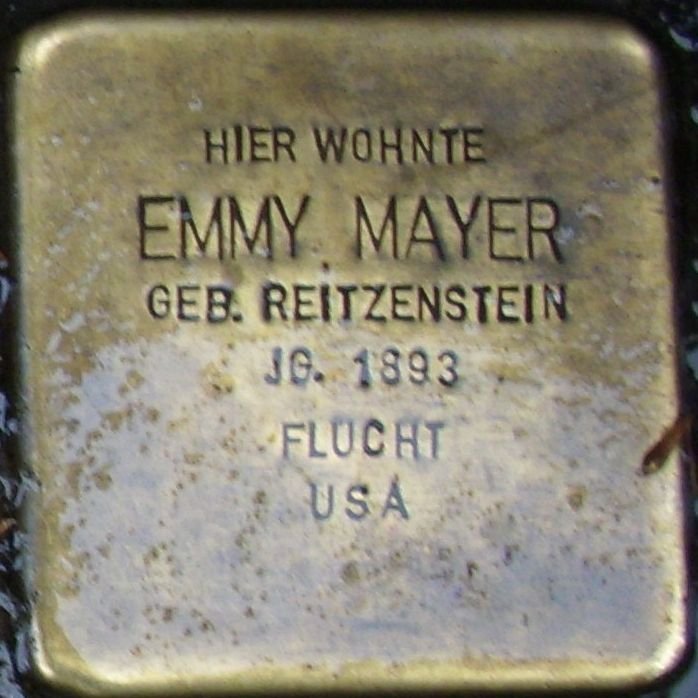
Stolperstein for Emmy Mayer in Mainz, Germany: A Visitor’s Guide
Date: June 14, 2025
Introduction
The Stolperstein for Emmy Mayer in Mainz, Germany, offers a poignant encounter with history and the Holocaust’s enduring impact. Part of artist Gunter Demnig’s Stolperstein project, this small brass plaque embedded in the pavement marks Emmy Mayer’s last freely chosen residence. This guide provides comprehensive information for visiting the Stolperstein, including historical context, accessibility details, nearby attractions, and ethical considerations.
The Stolperstein Project: Origins and Scope
The Stolperstein (“stumbling stone”) project, initiated by German artist Gunter Demnig in the early 1990s, is the world’s largest decentralized memorial. It commemorates victims of Nazi persecution by placing small brass plaques in the pavement outside their last chosen homes (IamExpat). Each stone is engraved with the individual’s name, date of birth, and fate. The project began in Germany and has expanded to over 30 European countries, with over 100,000 Stolpersteine installed (IamExpat).
Stolpersteine in Mainz: Emmy Mayer’s Story
Mainz actively participates in the Stolperstein project, with stones commemorating numerous victims, including Emmy Mayer. Her Stolperstein is located in Mainz’s Oberstadt district on Friedrich-Schneider-Straße (SWR Aktuell). The Stolpersteine Mainz website provides further biographical details about Emmy Mayer and other victims. Her story, like those of countless others, underscores the devastating impact of the Holocaust on Mainz’s Jewish community (Stolpersteine Mainz).
Visiting the Stolperstein for Emmy Mayer
Visiting Hours and Access
The Stolperstein is accessible 24/7, free of charge. Its location on a public sidewalk allows for spontaneous visits at any time.
Accessibility
The Stolperstein is generally accessible to all. However, visitors with mobility challenges should be aware of potential uneven surfaces on the pavement.
Travel Tips
- Use public transportation: Mainz has a well-developed bus and tram network with stops near Friedrich-Schneider-Straße.
- Plan your route: The Stolpersteine Mainz website offers maps and locations of all Stolpersteine in the city.
- Consider combining your visit with other historical sites in Mainz.
Nearby Attractions
- Mainz Cathedral (Mainzer Dom)
- The Gutenberg Museum
- The Museum of Ancient Seafaring
- Mainz’s historic Old Town
Ethical Considerations for Visitors
- Respectful Conduct: Approach the Stolperstein with reverence. Avoid loud conversations or disruptive behavior.
- Photography: Discreet photos are acceptable, but refrain from posing or taking selfies directly on the stone.
- Cleaning the Stone: Gently polishing the brass plaque with a soft cloth is a customary gesture of respect.
- Leaving Tokens: Small stones or flowers may be left as tributes, in line with Jewish tradition.
Cultural and Social Impact of Stolpersteine
The Stolpersteine project has significantly impacted Germany’s culture of remembrance (Erinnerungskultur). By placing memorials at ground level in everyday spaces, the project fosters ongoing engagement with history. The act of “stumbling upon” these stones encourages reflection and remembrance (IamExpat). While the project enjoys widespread support, some debate exists regarding the placement of memorials at ground level (IamExpat).
Educational and Community Initiatives
The Stolpersteine project is often integrated into educational programs and community initiatives. Local organizations, schools, and families frequently sponsor stones, research biographies, and organize commemorative events (Stolpersteine Mainz).
Digital Resources
Several digital resources enhance the Stolperstein experience:
- The Stolpersteine Mainz website offers interactive maps, biographies, and historical information.
- Apps like “Stolpersteine NRW” provide scanning features and access to detailed victim biographies.
Conclusion
Visiting the Stolperstein for Emmy Mayer is a powerful way to connect with history and honor the memory of Holocaust victims. This guide encourages respectful engagement and provides the necessary information for a meaningful visit. By learning about Emmy Mayer’s story and the broader context of the Stolperstein project, visitors contribute to a living culture of remembrance.


































































































































